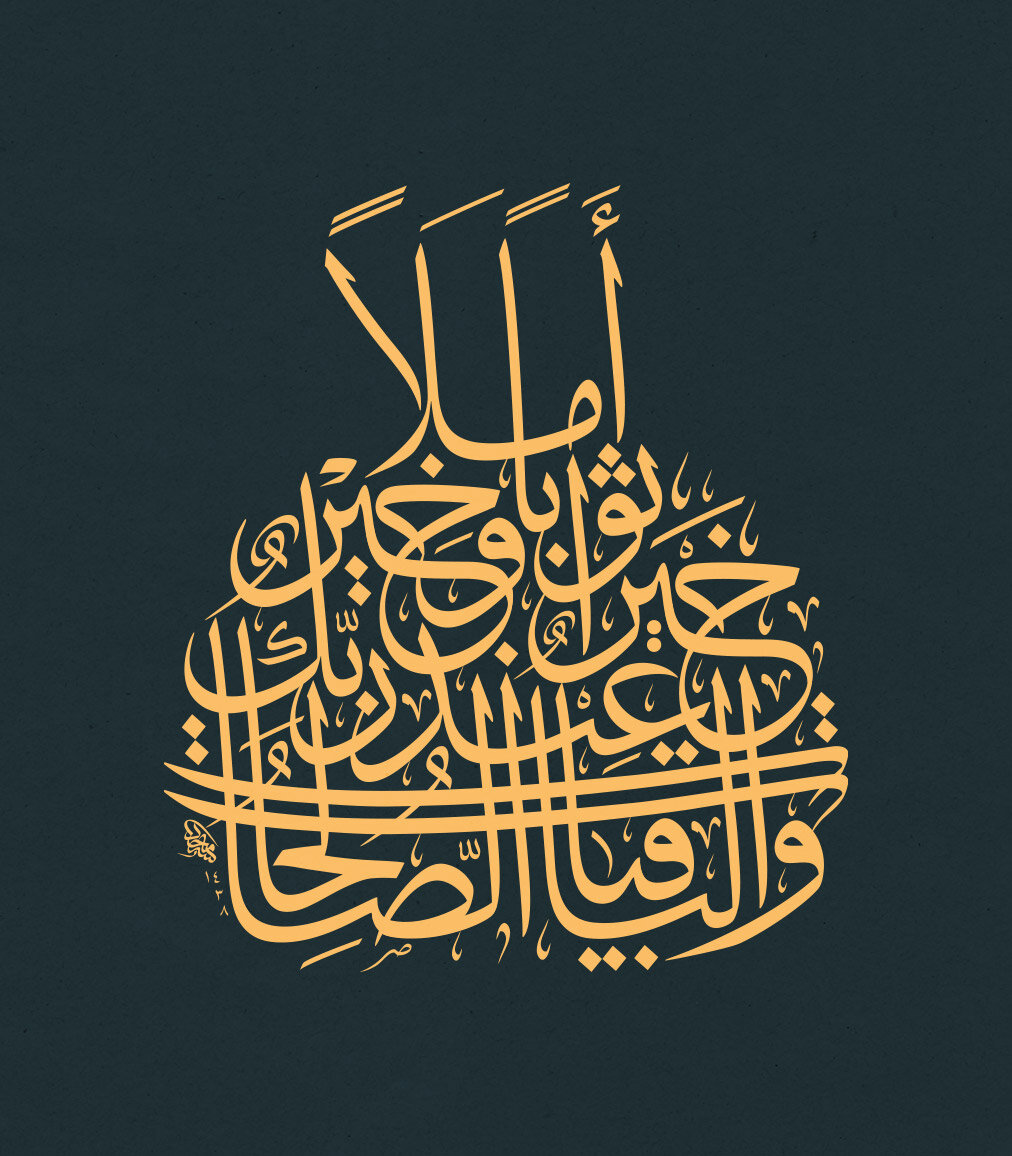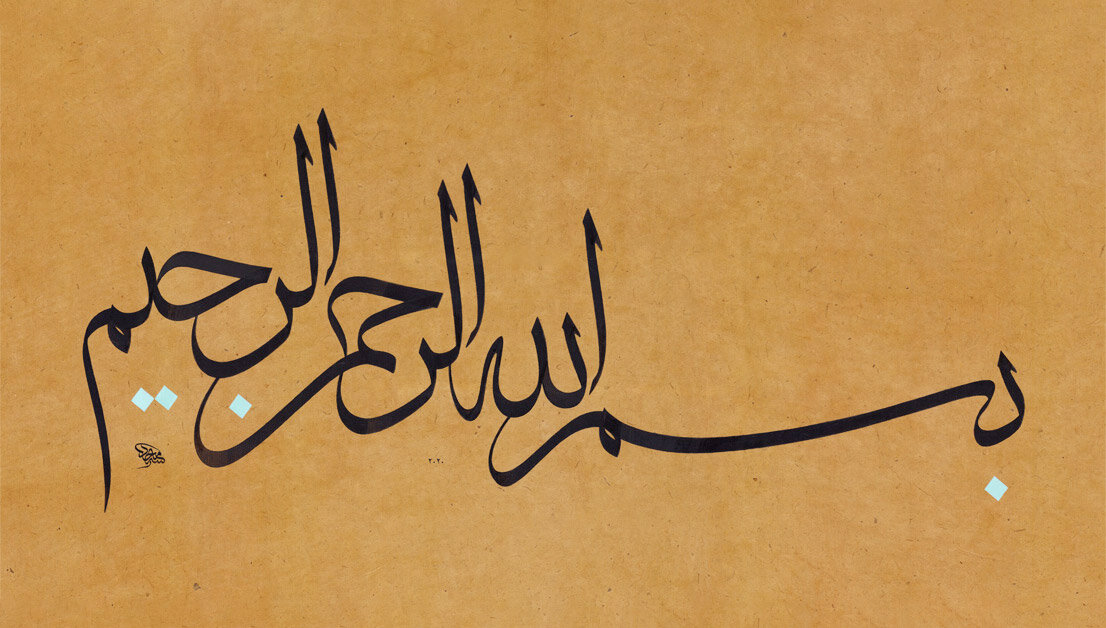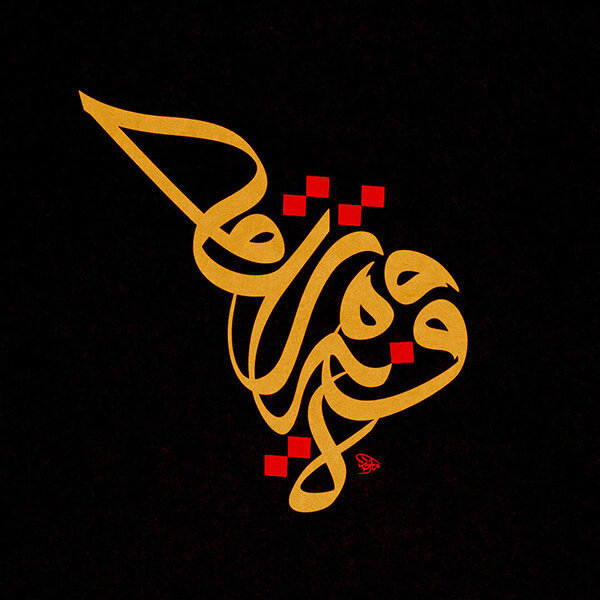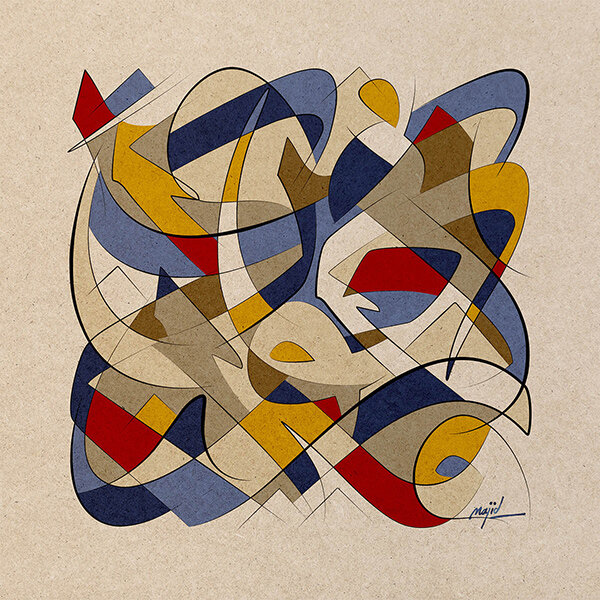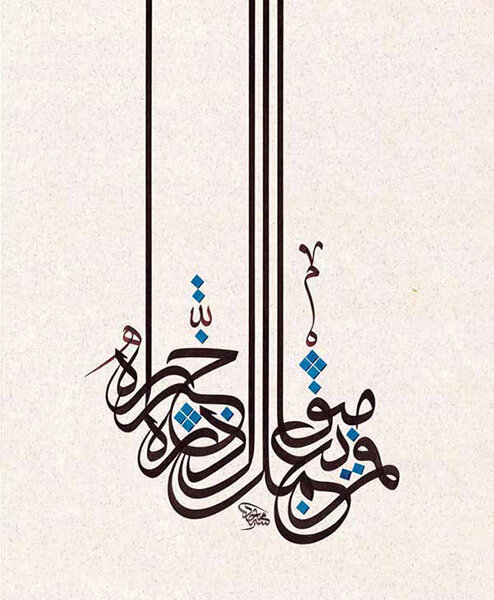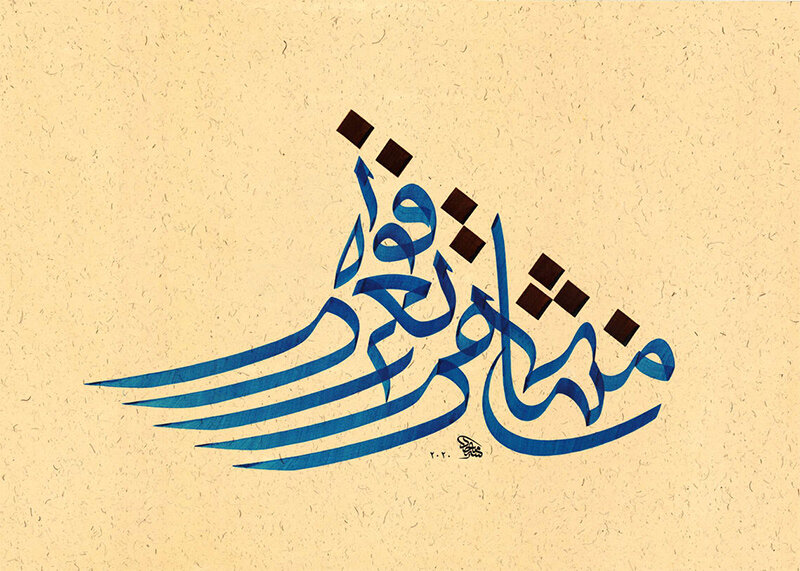Majid Alyousef’s art is often an interplay between classical form and abstract art. Alyousef’s revolutionary style of converging his mastery of traditional Arabic calligraphy with modern abstract art has gained him international attention. Practicing the art of Arabic calligraphy for over 30 years, he continues to perfect his work through the exploration of new and innovative ways of representing Arabic letters.
Majid Alyousef is a Dubai-based award-winning master calligrapher, designer, and typographer. Alyousef earned his Bachelor of Fine Arts in Iraq and a Master’s degree in Interactive Design and Game Development from the Savannah College of Art and Design in Georgia, US.
Alyousef has taught calligraphy and typography in various institutions and universities.
He participated in many international exhibitions, including Sharjah Calligraphy Biennial, Medina Calligraphy Exhibition among others. He also lends his expertise to and collaborates with various international branding, advertising agencies, and design houses. Alyousef has contributed his work to both private and public collections.
I recently reached out to Alyousef for an interview, which he very graciously accepted. He talked about his artistic journey and offered practical advice for aspiring artists and calligraphers alike.
You are an award-winning artist who specializes in traditional calligraphy and contemporary visual arts - What inspired you to take this artistic path?
Image courtesy: https://fridaymagazine.ae/
It started at a very young age. I was interested in visual arts and crafts in general, and as my drawing and painting skills started showing in school projects, my handwriting though was slightly lagging behind. One of the teachers back then told me to improve my handwriting, I think that was the trigger. Actually, the moment I discovered the existence of calligraphy pens with chiseled nib and the shapes they make on paper was so special. That moment was like a revelation and I got hooked ever since. I am fascinated by letters and these various intricate shapes and forms. they exist in their own world and create their own rules and relationships.
How do you come up with your compositions? What art forms do you draw upon outside of the calligraphy world?
On composition:
Diligent research and experimental sketching and doodling drills are the way I start testing my concept. this applies to both classical and modern artworks. in the classical path, I study the words I am working on, see how they visually relate to one another, as a whole, or just partially, then I emphasize the special relationships that they potentially have in order to create a sort of visual infusion.
A careful and thorough study of the letterforms, extensions, straight lines positioning, curves, and terminals follows. By that time the basic composition starts to reveal itself. you can see how I use parallel shapes, crossing strokes, and elements proximity to building the composition.
I don't limit myself to the basic forms of compositions (e.g., circles, rectangle, oval) and try to come up with new freestyle silhouettes and inside that daring and experimental letter connections that are not used before yet benefit from the genius of the classical calligraphic values and its aesthetic richness.
As for the second part of the question:
Architecture may be the most influential to me. The experience of moving in space and the exploration of extra dimensions through time has been always so mystical. In my work, I do recall these special moods and atmospheres as I construct the basic elements of lines and colors and deconstruct letters as we know them to form new structures and compositions. in the art world, cubism and futurism have been vividly participating in my process and way of thinking. In my abstract designs, the spirit of an avant-garde cubist or a futurist can be detected easily.
I do also get a lot of inspiration from science and music but indirectly as they don’t communicate in the visual form right away. It usually leads to a series of interpenetrations between the lines, colors, time, and blank surface. I call all that the inspiration phase.
You co-founded Calligraforms, can you briefly explain what it is? And if one is interested in learning this art, how does one do it?
Calligraforms is more a way of thinking or an attitude rather than a specific style. it is based on utilizing the classical aesthetics of calligraphy like in my case (Thuluth script mostly) and represents that in a new and more reaching exposure.
I felt that there is a lot of beauty in calligraphy that goes beyond its function of creating reading material. If you like to read, you get a book instead of going to a gallery to enjoy a painting. Thus, abstract calligraphy may willingly avoid casting headlines or presenting a conventional copy. it is a different realm where the artwork candidly presents its own reason and purpose.
Calligraphy for me is not just an imitation of shapes or objects that we do when we start learning in order to understand the intricacy of this form of art, but it's a way to give our senses and instinct a pliable perception.
So, I started my research by studying other art movements and art philosophy. I wanted to understand how I can show value to viewers and how to communicate with them, especially that it’s a totally new approach.
I focus on using the outlines of letters to create profiles these profiles then are sliced and re-arranged in a more experimental order to make a composition. Colors then used to fill parts of the newly generated spaces and signal different stories or scenarios. The aesthetic value becomes the task of paying attention to microscopic details without losing sight of the nuances of perspective. That comes from the grasp of calligraphy and its demanding intricacy along with the overall understanding of design and composition.
For someone to learn and work in this particular direction, it is very important to start by studying calligraphy in its purest forms, practice with reed pen and ink, and deepen her/his knowledge in it then the creative flow will work its magic and the tedious classical calligraphy work grows to a fruitful art that is not limited to specific context or language and can be appreciated globally.
My objective is to discover new perspectives that the elegance of calligraphic forms, which was developed over many centuries to reach this level and could be presented in a more thoughtful context with a more sharp and bold statement. Talking more technically each letter is developed and crafted in a specific shape or direction that was the thing I like to show in my work.
The motive to make abstract and painterly calligraphy style is the big void that calligraphy could enrich. Letterforms have a lot of potentials, aesthetical values laying in their tiny details, but it was not explored or unleashed in an abstract context. Several fine artists, painters, graffiti artists, and typographers from various backgrounds wanted to develop their artwork inspired by Arabic calligraphy but they lack the craftsmanship and thorough knowledge of letterforms structure and anatomy, which caused their work to be rather a celebration of texture formed by a “mardi gras” of stacked letters and colors, a would-be so nice composition but filled with very poorly crafted letters or words which I think is a mediocre representation of this field of art. I don’t generalize here since very few artists did good and outstanding jobs. But in the general art scene aside from that is overly crowded with mediocrity.
What makes a piece a great work of art?
I empathize with the importance of mastery in the way the letterforms are presented -since we talk about calligraphy here. It's art mastery that comes first in this context.
An outstanding piece of art goes way beyond the textbook mechanical aesthetics to express the duality of its dynamics; the motion in the form itself and motion of the form in relation to other forms on the canvas or in space in the case of spatial design and sculpture.
Originality comes from the idea, the medium, the presentation style, and the process of making authentic elements and actors that the artist uses in the painting. The artwork doesn’t have to include all these factors though.
Unity is an important factor, artworks with many elements need to be carefully designed to show a unified theme or spirit that underpins the extravaganza.
Understanding that the artwork is a bi-directional subjective experience and viewers will create their own narrative as they see the artwork which may deviate from the initial intentions the artist wants to convey. This actually could be a positive aspect that the artist should use. making artworks more engaging by making them flexible enough to adjust to fit the viewer's story.
Your advice for students who want to follow your path, or generally.
A strong will and patient work is a good way to start.
Calligraphy is one of those fields that requires motor skills, knowledge, and creative ideas. A calligrapher is also a craftsman, and artisan, and a designer.
Learning traditional calligraphy is very important, and I mean studying it enough and thoroughly not just getting to know it casually.
Studying design and art in other cultures and learning more about the global human quest with art and design would be incredibly valuable.
Creative sparks have no rules, so develop a way of taking notes or sketch even if you don't have access to your complete toolkit. Maybe a traditional sketchbook and a pencil or a sketch/note app will save the moment.
Open new creative passages in your brain by learning about subjects that may not be of direct connection to your current interests. sometimes reading a paragraph or an article about something you are not interested in turns out to be a kind of good mental workout.
The more you learn the more you will find yourself in need of more knowledge.
For information on Alyousef’s work, please visit his website: https://majidalyousef.net/
Instagram: @majid_alyousef
Art images courtesy of the artist
Gallery of Alyousef’s artwork:
